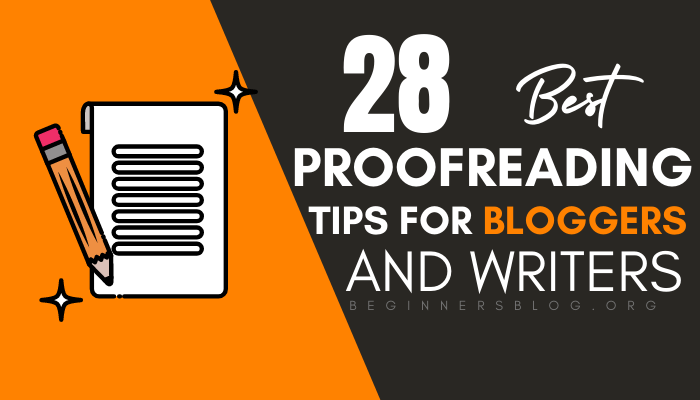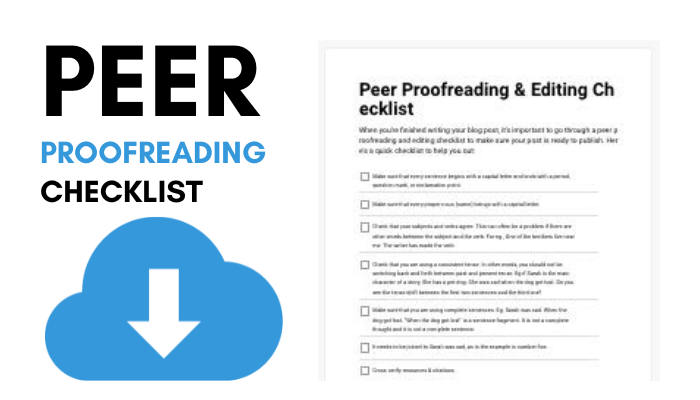If you’re a blogger or writer, you likely have much experience in writing, but you probably don’t know how to proofread your work.
If that’s you, you need to start learning how to proofread your work before submitting it to editors or publishers. That being said, I’m going to share the best proofreading tips you can learn to polish your final document.
So let’s get started…
1. Don’t Proofread On The Same Day:
It would be best to always proofread your work on a different day than when you wrote it. This is because your mind will be fresh, and you’ll be able to spot mistakes more easily. It also helps if you’re working with an editor who has their own set of eyes to see what they think are errors.
2. Read Your Work Out Loud:
This is one of my favorite proofreading tips for writers. When reading aloud, you’ll notice things like spelling mistakes, grammar errors, and other issues that might not stand out as glaringly evident in your written version.
3. Use An Online Tool To Find Errors:
Many online tools are available to help you find errors in your work. Some of them are ProWritingAid, and Hemingway App. All three of these tools offer free versions, so you won’t have to pay anything to use them.
4. Look At Each Word In A Sentence:
When you read aloud, you’ll notice words that sound strange or funny. These are called “word-level” errors. You want to make sure that each word in a sentence sounds right. So look at every single word in a sentence.
5. Avoid Distractions:
If you’re working in a noisy environment, you should work in a quiet room away from distractions. If possible, turn off your mobile while proofreading.
6. Have a second pair of eyes check your work:
Ask a friend or family member to read your work for an unbiased review of your content. They’ll point out grammatical errors or inconsistencies in your piece.
7. Make Notes As You Go Along:
Make notes about what you’ve noticed while proofreading. Write down the areas where you found problems. This way, you’ll remember what you did wrong later.
8. Use a Highlighter to Mark Errors:
Highlighting your errors makes it easier to identify them later. Once you’ve marked up your document, you can go back over it and reread your highlighted sections.
9. Cross Verify Researched-based Written Data:
If you’re writing about something you learned from research, cross-check your facts. Research is essential, but you shouldn’t just copy and paste information into your text without verifying its accuracy.
10. Check For Consistency:
Consistency is another crucial part of good writing. Make sure all your paragraphs follow the same structure. Also, check for consistency between sentences within a paragraph.
11. Reread Your Work:
Rereading your work after editing is very helpful. You may have made changes that weren’t necessary. Or maybe you missed some mistakes. Either way, rereading your work will ensure that everything flows smoothly.
12. Check For Redundancy And Wordiness:
Redundancy occurs when you add unnecessary words to your piece. Wordy writing is when you use too many adjectives and adverbs. Reducing redundancy and wordiness will improve your writing style. Both of these types of errors can slow down your reader’s pace.
13. Turn Passive Sentences into Active:
Passive sentences do not include any action verbs. And instead, they describe others’ actions. Active sentences tell readers what you do. Examples of passive sentences include: “The dog was chased by the cat.” vs “The cat chased the dog.” The second example uses an active verb, telling the reader what happened instead of describing what the other person did.
14. Breakdown Long Paragraphs into Small Paragraphs:
Long paragraphs can be challenging to read. If possible, break up large paragraphs into smaller ones, and it improves readability and enables users to read more quickly.
15 . Get Rid Of Wrong Pronouns:
There are two main kinds of pronouns in English: personal and possessive.
Personal pronouns replace people’s names (I, me, my). Possessive pronouns replace things like “my book,” “your car”, etc. (Mine, yours, ours). When using pronouns, make sure you know who or what you’re referring to. Otherwise, you could end up saying something incorrect.
16. Check For Punctuation:
Punctuation marks distinguish ideas in your writing. Punctuation includes periods, commas, colons, semicolons, question marks, exclamation points, dashes, parentheses, brackets, ellipses, quotation marks, apostrophes, ampersands, hyphens, and em dashes. They can help clarify your meaning and give your writing flow. However, if you leave one of these marks, your message might get lost.
17. Avoid clichés:
Clichéd phrases are common expressions that seem trite, and they often appear in advertising and marketing materials. Try to avoid using them in your writing. Instead, find original ways to convey your message.
18. Use proper Capitalization :
Capitalize only the first letter of each sentence. Capitalizing every letter except the first one will make your writing look sloppy.
19. Don’t Use Contractions:
Contractions are shortened versions of longer words. They are usually used in informal speech, and using them in formal writing will sound awkward and unprofessional.
20. Use Transitional Words:
Transitional words link different parts of your text together, and these words include conjunctions, prepositions, and articles. Transitional phrases are important because they help guide your reader through your writing. Without them, your writing would lack cohesion.
21. Double-check For Homonyms:
Homonyms are words with similar sounds but different meanings. Homonyms can confuse and lead to spelling mistakes. To prevent this from happening, double-check your work before sending it off.
For example, saw (a cutting tool) and saw (the past tense of see) are homonyms.
22. Get A Hard Copy Of Your Document:
When proofreading your document, print it out on paper. This way, you can easily spot missing words and grammatical errors and correct them before submitting your project.
23. Prepare Yourself Mentally:
Proofreading requires patience, concentration, and attention to detail. So do not expect to finish reading your entire document within just a few minutes. Take time to go over each paragraph carefully. Be patient, do not rush.
24. Proofread More Than Once:
If you have made any changes to your document after the initial proofreading, reread it. Make sure everything still makes sense. If anything seems unclear or wrong, fix it immediately.
25. Develop Essential Proofreading Skills:
To become an effective proofreader, develop the following essential skills:
- Reading comprehension – Read your documents thoroughly, so you understand the content.
- Grammar knowledge – Know when to use specific grammar rules.
- Writing skills – Practice good grammar and punctuation.
- Get to know the Publishing rules – Learn about the publishing industry and its standards.
- You can refer to a course to become a professional proofreader.
26. Use The Company’s Style Guide While Proofreading:
A style guide is a set of guidelines that tells you how to write according to a particular organization’s requirements. It helps you follow standard practices and conventions.
As a writer, you need to learn how to use style guides to ensure that your work meets formatting and consistency standards.
Many companies provide their style guides. Some organizations also offer online resources that teach you to format your documents correctly.
27. Check For Acronyms and Abbreviations
Abbreviations (Mr., Dr., etc.) and acronyms (NASA, NATO, etc.) are shorter versions of existing words and phrases. They are commonly used in business communications. When using abbreviations, make sure you spell them correctly. Also, be careful when using acronyms. Do not use them if you cannot explain what they stand for.
28. Make Use Of These Words Correctly:
There are words (like there – their – they’re, affect – effect, its – it’s, accept – except > you’re – your) that most writers tend to use incorrectly. Misusing these words can change the meaning of sentences. So, check your work for these common word errors.
Conclusion:
As a blogger or writer, you should always proofread your posts/documents before publishing them. Doing so will help you avoid making embarrassing mistakes that could harm your reputation.
Do you want to share more proofreading tips? Let me know in the comment section.
Good luck!










